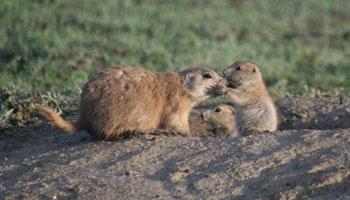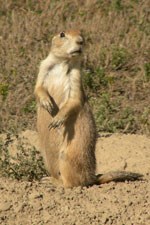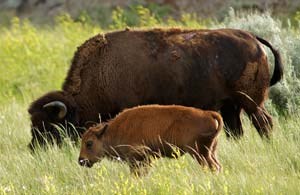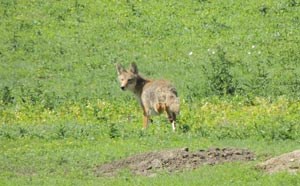
NPS photo Furry Friends Animals are grouped in a class by their common traits. All mammals share these features:
If you were keeping track, you might have noticed that humans have all of those features. That means we are mammals! Mammals can be all shapes and sizes. At Theodore Roosevelt National Park, we have tiny chipmunks which could fit in your hand, and we have the largest mammal in North America: the bison! One of the coolest mammals you can see in the park is the black-tailed prairie dog. 
NPS photo Black-tailed Prairie Dogs Black-tailed prairie dogs are not dogs at all! They are a rodent, like a squirrel. They earned their name because they bark to alert other prairie dogs of danger. French explorers called them petit chien, which means "little dog." Prairie dogs live in huge communities called towns. They burrow, or dig, into the ground to create their shelter. These burrows can be as deep as 15 feet! Tunnels connect different rooms the prairie dogs use for sleeping, raising young, and whatever else prairie dogs do underground. They spend half of their lives in their burrows, so they must have pretty nice homes down there! When they are not below ground, prairie dogs are eating food and watching for danger. They are herbivores, which means they eat plants. They clip down all the plants in their town so predators, like coyotes and badgers, have less places to hide. Prairie dogs build mounds at their burrow entrance to give them a better view of their town while they look for threats. If they do see something, they bark and chirp to alert the other prairie dogs. It is pretty funny to watch them all scurry around to hide in their burrows! Prairie dogs and their towns support lots of other life. Animals which help support their ecosystem are called keystone species. Grazers like bison and elk eat the fresh plants that grow in dog towns. Other animals like hawks and coyotes are hoping to eat the prairie dogs! Still other animals will use empty burrows for their own homes. Without prairie dogs, other animals would have trouble finding food or shelter on the prairie. 
NPS photo by Jeff Zylland Bison A common sight in or near a prairie dog town is the American bison. They like the fresh grasses and plants that grow in the dog towns. In Theodore Roosevelt's time, bison almost went extinct. An animal becomes extinct when there are no more left. Although Roosevelt hunted bison, he also worked to protect their habitat and save the last few animals from extinction. Today, hundreds of wild bison roam the park. They are often seen in large groups called herds. Sometimes you see a single bison, because the older males like to hang out by themselves. In the late summer and early fall, bison gather in large numbers for their rut. It is like a big party that all the bison are invited to! Bison are the largest land animals in North America. They can move fast and are very strong. Normally, they just roam the prairie munching on grasses. Because they are so big and strong, bison have few natural predators. Animals that can hunt bison, like wolves or brown bears, no longer exist in the area of Theodore Roosevelt National Park. Every few years, the park rounds up the bison and removes some. They are given to Native American tribes and other parks that need bison. Predators Many of the large predators from the prairie are gone. When people began ranching and farming on the prairie, they changed the habitat these animals needed to survive. Animals like wolves, mountain lions and bears need a lot of space. As big as the national park is, it does not have enough habitat for these predators. 
NPS photo by Andrew Rankin The park is still home to many small predators. Some we will learn about in other sections because they are not mammals! Predators that are mammals include coyotes, bobcats and badgers. These animals are hard to spot. Many are nocturnal, which means they are more active at night. These predators feed on prairie dogs, mice, birds, snakes, insects, and even plants and berries! Unlike some kids, they are not very picky eaters! Animals like the coyote eat both plants and animals. They are called omnivores. That finishes our research on mammals. There is still a lot to learn, since mammals are one of the largest classes of animals in the park. There is a larger class, but it is made up of the smallest creatures! Keep reading to learn more about insects! You can also go back to the main Wildlife page, or return to the first Learn About the Park page. Go to the vocabulary page to review the blue words you learned here. |
Last updated: August 20, 2015
